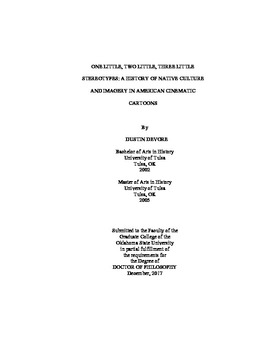| dc.contributor.advisor | Bryans, William S. | |
| dc.contributor.author | Devore, Dustin Marcus | |
| dc.date.accessioned | 2018-06-18T16:02:33Z | |
| dc.date.available | 2018-06-18T16:02:33Z | |
| dc.date.issued | 2017-12 | |
| dc.identifier.uri | https://hdl.handle.net/11244/300089 | |
| dc.description.abstract | The first depiction of Native Americans in American cinematic animation appeared in 1924. Over the course of the near one hundred years since that first depiction, federal Indian policy and the portrayal of Indians in popular culture changed. The paternalistic assimilationist views of the early-and mid-twentieth century gave way to tribal self-determination in the late-twentieth century and into the twenty-first. In addition, attitudes toward the portrayal of minorities in popular culture progressed in the United States during this period. As these changes occurred, animation underwent transitions in style and content. The ages of animation include the Silent Age (1906-1928), the Golden Age (1928- 1960s), the Dark Age (mid-1960s - early-1980s), the Renaissance Age (mid-1980s - mid-1990s), and the Millennium Age (1995 - present). The animation industry is dominated by white males; as such, the portrayal of Native Americans in cartoons lacks Indian agency. The result is the creation and perpetuation of stereotypes that have lasted for nearly one hundred years. Indians in cartoons range from mindless villains, to noble savages, to shrewd casino executives bent on getting revenge against the white man. The power of these stereotypes is multiplied by the broad audience that cartoons reach that includes children who view these images during their formative years. The purpose of this study is to chronicle the history of Native American depictions in animation, analyze how and why they changed, and evaluate their impact on American attitudes toward Indians. This study expands the field of popular culture studies on Native American imagery by focusing on a neglected medium in historical scholarship. | |
| dc.format | application/pdf | |
| dc.language | en_US | |
| dc.rights | Copyright is held by the author who has granted the Oklahoma State University Library the non-exclusive right to share this material in its institutional repository. Contact Digital Library Services at lib-dls@okstate.edu or 405-744-9161 for the permission policy on the use, reproduction or distribution of this material. | |
| dc.title | One little, two little, three little stereotypes: A history of native culture and imagery in American cinematic cartoons | |
| dc.contributor.committeeMember | Moses, L. G. | |
| dc.contributor.committeeMember | Smith, Michael Myrle | |
| dc.contributor.committeeMember | Miller, Douglas K. | |
| dc.contributor.committeeMember | Perkins, Stephen M. | |
| osu.filename | DeVore_okstate_0664D_15476.pdf | |
| osu.accesstype | Open Access | |
| dc.type.genre | Dissertation | |
| dc.type.material | Text | |
| thesis.degree.discipline | History | |
| thesis.degree.grantor | Oklahoma State University | |
